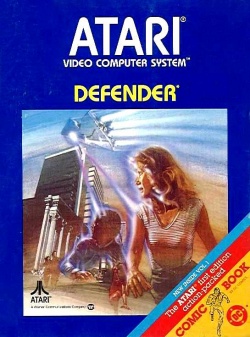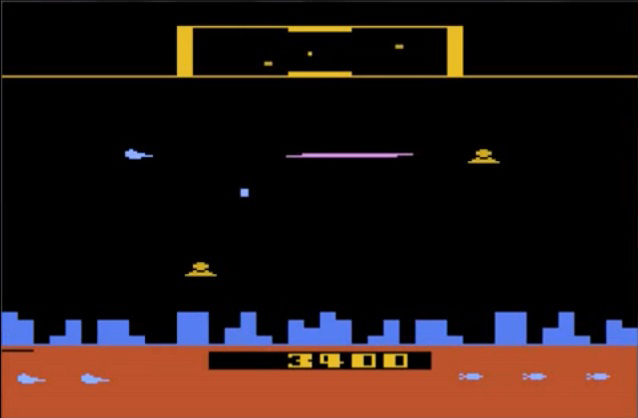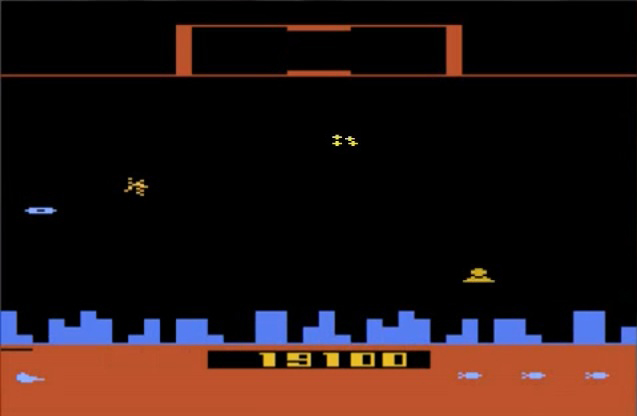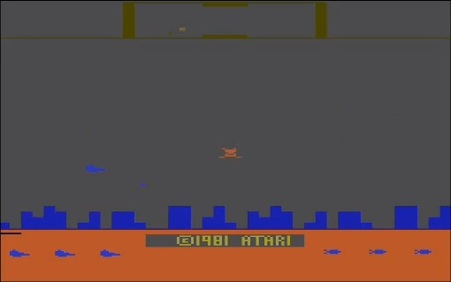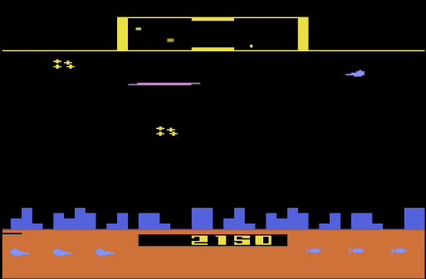DEFENDER (2600)
It’s fair to say that in video gaming’s infancy, almost every new development that cropped up in the arcades was genuinely fresh and exciting. One of the first genres to emerge was the shoot ‘em up; born out of 1962’s Spacewar!, followed up by the huge global success of Space Invaders, the next stage of the shooters evolution was environmental movement, thus the scrolling shooter came to us in the form of the pioneering Defender. This 2D style would inspire the likes of Gradius, R-Type and Xenon to become firm favourite space blasters. As one of the earliest and most famed games consoles, the 2600 was adorned with many ports of the arcades of the late seventies during the first gaming heyday, and Defender was no exception as one of the most popular coin-ops of the day. It translated across to the home with issues, but still maintained that vital edge of progression.
Interestingly, Defender isn’t as basic as you would envisage, even being supported by a brief plot behind the rocket fire and now universal alien-mutant lasering. It also presented the gamer with goals outside of merely shooting down enemies, another big leap into hyperspace. The classic shooters Space Invaders and Asteroids provided the primary inspiration behind Defender; the space setting and multiple targets, but as Williams developed it, it became something unrecognisable from these titles, the crucial difference being the scrolling aspect. Controlled by the movement of the player, the screen scrolls in both directions, increasing the playing field size exponentially from previous titles. The difficulty was raised and more variety became an organic side effect. Static shooters didn’t have this dynamic, so the sprite movement of 4 directions became essential to Defenders success. Like Space Invaders, there’s a range of enemy designs, however, what differs is the behaviour of each alien, requiring each to be dispatched with alternate thoughtful methods. Most notably the Landers, who instead of attacking, try to snatch poor humanoids (displayed as tiny white dots) from the ground. This brings an element of strategy to the game, as you not only try to prevent this, but attempt to catch the ailing civilian as they fall from a destroyed Lander. Other enemies have original behaviours too, the Baiters for instance hover over your craft teasing you to make a mistake, and the Swarmers charge head–on in a collision course. In other words, no simple matter of shoot and destroy.
Too many colours for the early eighties. Far too many. Look: even orange!
The layout and interface of this version is remarkably similar to that of the arcade, with some compromises due to the 2600’s limitations. Graphically things are solid enough; with the ground changed to buildings rather than a ridged surface, less colour and detail on the sprites and larger text. The innovative radar display along the top retains its presence, an excellent feature of the game, and the scrolling itself is surprisingly smooth and fast. Another nice aspect is the rainbow effect of the laser, but all these high points are let down with one glaring and serious fault. Screen flicker. Since there is a lot going on at any one time, it appears the hardware cannot handle things without the sprites and the mini-map flashing away with eye-straining ferocity. Every time you fire your ship vanishes momentarily, as do many of the enemies and their gunfire. Using a smart bomb or jumping into hyperspace is nigh on impossible to judge whether the action you wanted actually happened. Most of all, catching the falling humanoids as they blip in and out of existence becomes such a chore that you end up leaving them to their gravity-inflicted doom. This is all a big shame, as the design is functional and orderly, the primitive sprites are neat and the mechanics are mostly reliable. Making a better effort are the SFX, with faithful reproductions of the arcades sounds which are loud, distinctive and constant. The trademark intro zappy riff declaring that shooting will commence remains gleefully intact.
Anyway: just blow everything to merry hell and survive!
The other facet that Defender made apparent was the challenge it sets the player; it’s a difficult game, drawing the line in quick-drying cement setting the template for future scrolling shooters. Much as I welcome hard games, this version is made all the more unnecessarily difficult by the graphical problems, turning an enjoyably tough task into an unbearable and exasperating hard slog. The action can be very frantic and congested, responses need to be sharp, and whilst the handling, collision detection and movements are okay, that ever-present flicker is always on hand to kill you off at a nanoseconds notice. Swarmer’s appear in front of you out of nowhere, Mutant’s splat you in a blink of an eye materialising out of thin air. Very annoying, but with a little perseverance, it can be satisfying to clock up a good score. The single-button control system the Atari employs works well with general firing, though using the special weapons can feel dim-witted, but having the ability to hyperspace jump merely by reaching the top edge does often get you out of a tight spot.
Regardless of the popularity of this adaptation of Defender, it’s not what it should have been, and is certainly no threat to the Colecovision’s much more playable and accurate port. There are some little improvements over the arcade game, such as the building landscape, and the drawing of the visuals is not to be sniffed at, but the flicker problems are far too detrimental to give it a higher rating as they hinder things from the very start. All its innovations and general progressiveness remain intact, dutifully replicated to serve as a reminder of just how important this game is, but it sadly seems that this was another example of a great game let down by rushed programming. That said, Defender remains a lovely piece of genre-defining gaming. It’s challenging and raw, and is worth indulging in for a few minutes of your time. Just don’t hang around for too long if want to avoid your head exploding.
Regardless of the popularity of this adaptation of Defender, it’s not what it should have been, and is certainly no threat to the Colecovision’s much more playable and accurate port. There are some little improvements over the arcade game, such as the building landscape, and the drawing of the visuals is not to be sniffed at, but the flicker problems are far too detrimental to give it a higher rating as they hinder things from the very start. All its innovations and general progressiveness remain intact, dutifully replicated to serve as a reminder of just how important this game is, but it sadly seems that this was another example of a great game let down by rushed programming. That said, Defender remains a lovely piece of genre-defining gaming. It’s challenging and raw, and is worth indulging in for a few minutes of your time. Just don’t hang around for too long if want to avoid your head exploding.
|
|
VERDICT
Visual: 5/10
Audio: 7/10 Gameplay: 8/10 Longevity: 4/10 OVERALL: 6/10 |
